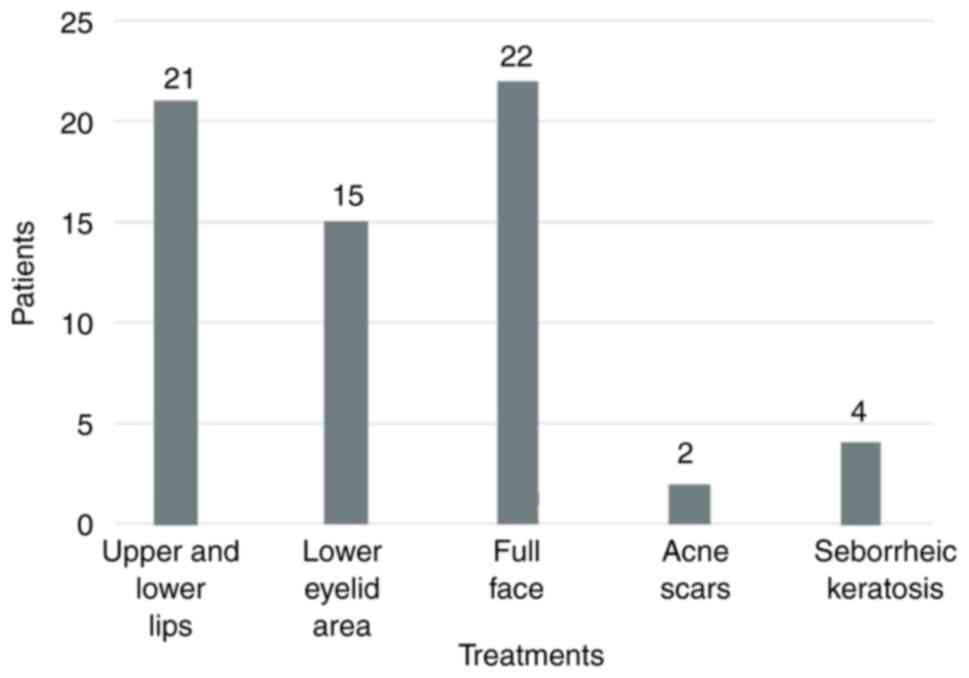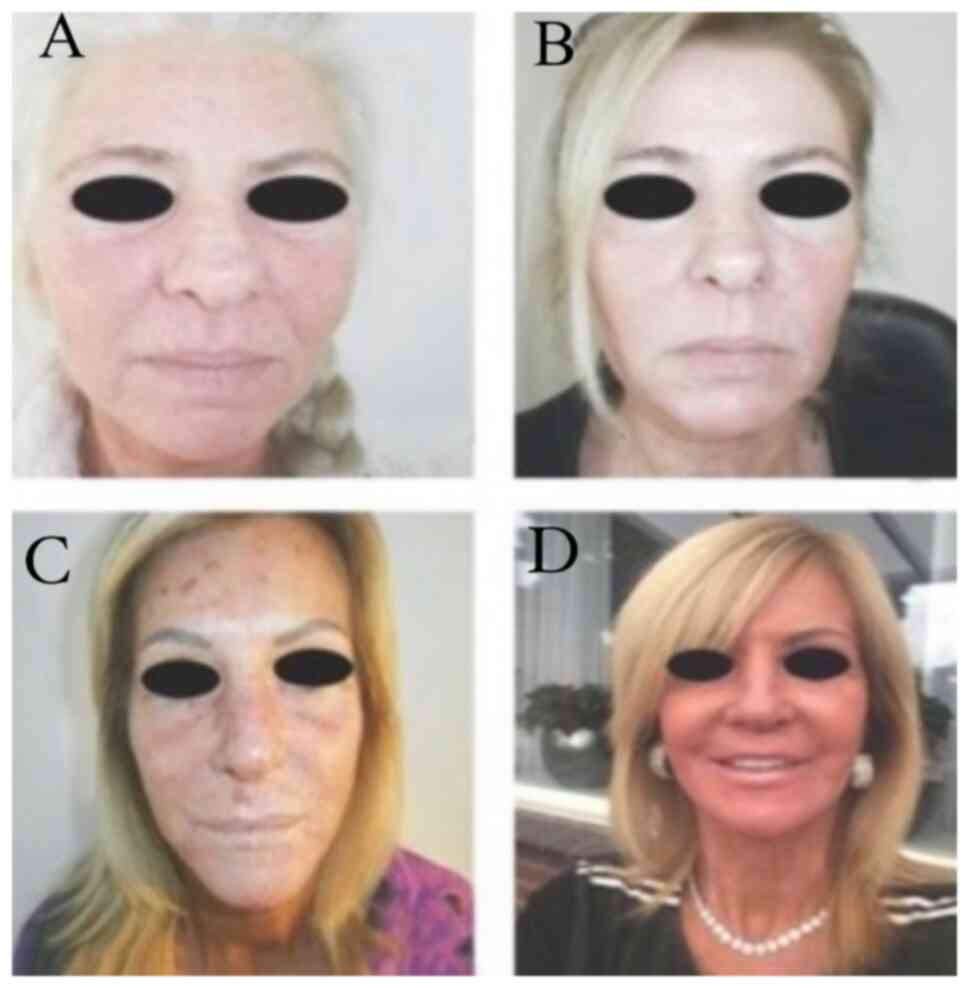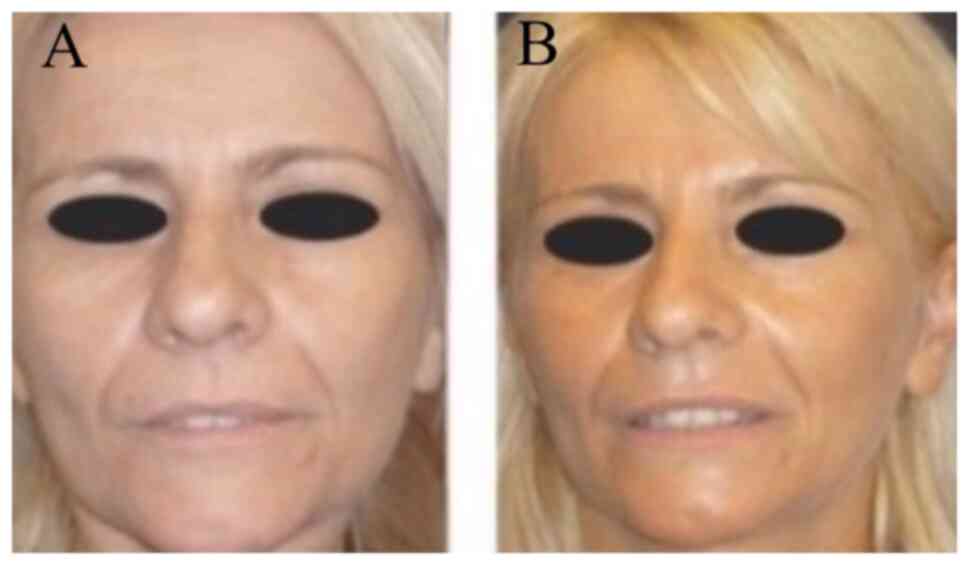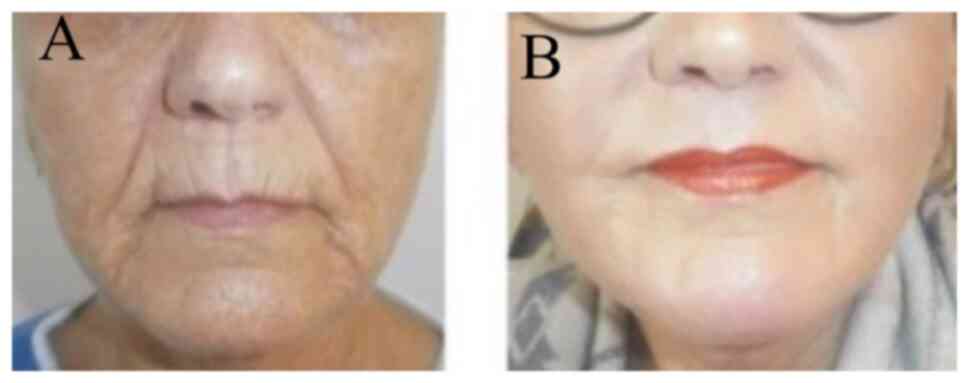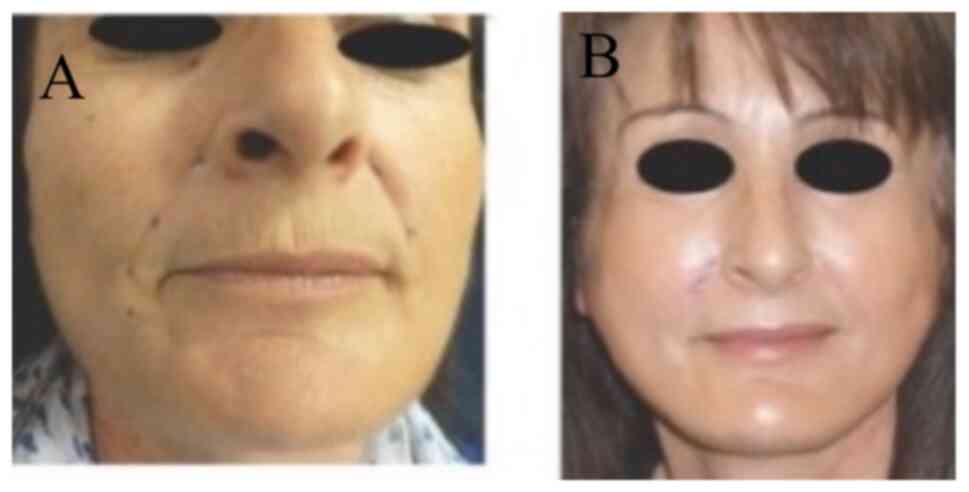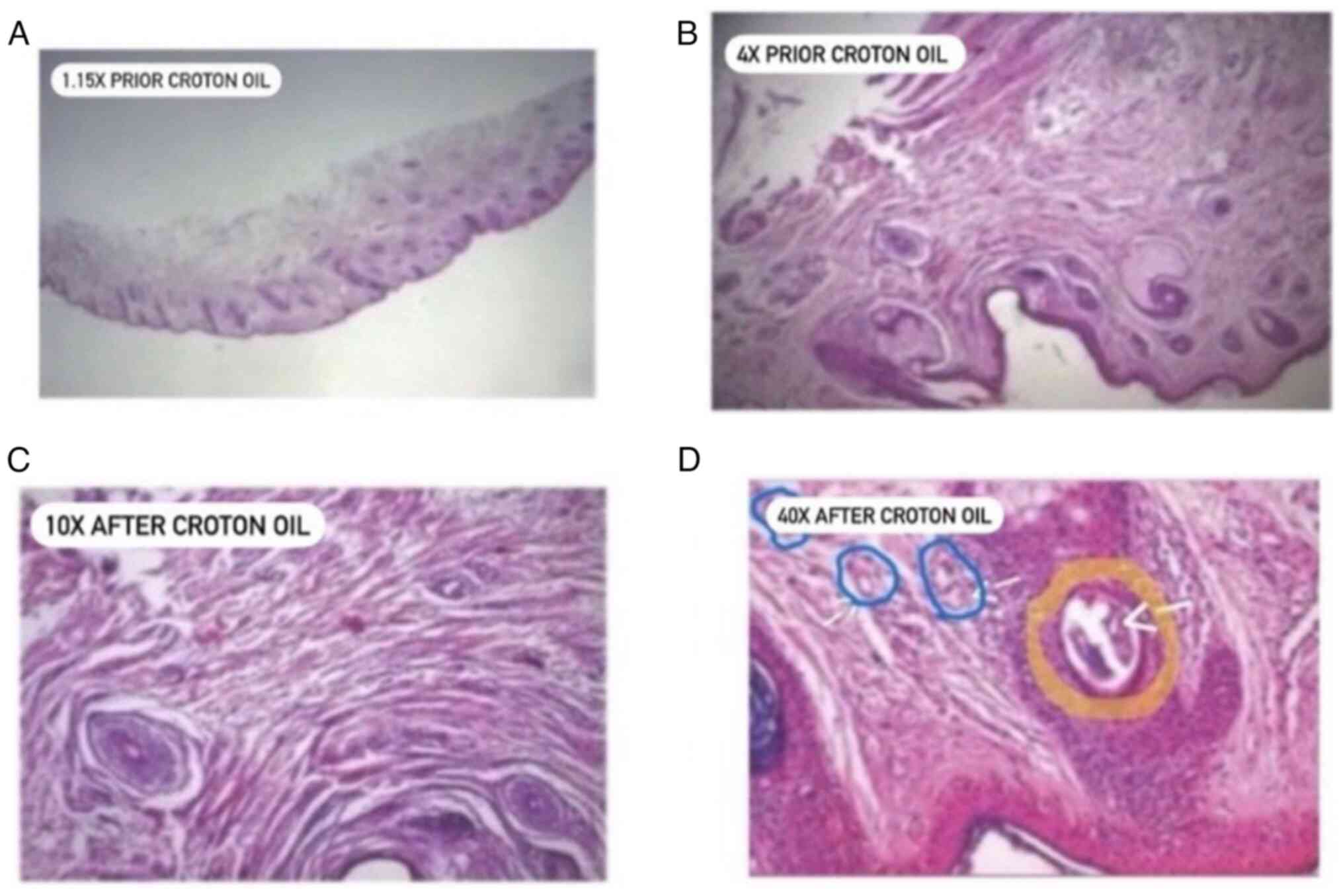Clinical aspects and risks of the phenol/croton oil
- Authors:
- Published online on: September 11, 2024 https://doi.org/10.3892/etm.2024.12711
- Article Number: 422
Abstract
Introduction
Chemical peels are divided in superficial, medium and deep; they can be applied at the whole face or they can be used in different aesthetic facial units; at the lips, the lower eyelids, the forehead and the temporal regions (1).
Superficial peels brighten the skin; the more acidic the peel is, the deeper the penetration will be. The main types of superficial peels are a-hydroxy acids such as glycolic/lactic acid and b-hydroxy acids such as salicylic acid, while ‘Jessner's’ solutions with ethanol are universally used as peel accelerators (2). They are safe, without severe complications and can be applied to all skin types (3).
Medium peels are mainly trichloroacetic acid (TCA) 10-35% and phenol 80%. The TCA penetrates the upper dermis to the stratum corneum and exfoliates the skin; it can treat actinic keratosis improving fine wrinkles and photoaging, pigmentary changes and/or acne scars (2).
Finally, deep peels are mainly TCA 50% and phenol/croton oil. Phenol/croton oil peels reach the mid-reticular dermis and can treat atrophic/pox-like acne scars, severe dyschromias and deep rhytids (2), solar lentigines, seborrheic keratosis, Bowen disease and angiosarcomas; they have been used as sclerosing agents or for chemical matrixectomy, the treatment of stable vitiligo and alopecia areata (2). Phenol (carbolic acid or phenolic acid) acts as a local anesthetic and disinfectant (2). It can be neutralized by glycerin or water and plays a key role in Baker-Gordon's formula, together with croton oil (3). Croton oil derives from the seeds of Croton tiglium plant (Euphorbiaceae family) and its medical applications have been well studied even from the 19th century. It boosts phenol's activity, coagulating the keratin (2). By using higher concentrations of croton oil, the concentrations of phenol can be lowered, therefore the systemic toxicity of phenol can be reduced. Baker et al (4) demonstrated that a 0.2% increase of croton oil concentration increases the phenol peel activity by 20%.
Despite its effectiveness, there are certain risks related to phenol/croton oil use, especially in patients with dark and thin skin.
The aim of the present study was to evaluate the clinical success of the phenol/croton oil peel, its pathological characteristics (at least from one patient) and the potential risks from its use.
Patients and methods
A total of 64 patients were treated with phenol/croton oil peel between January 2014 and April 2023. In total, 21 patients performed resurfacing at the oral area (upper/lower lips), 15 patients at their lower eyelids, 22 patients performed full face treatment, while 2 patients were treated for their acne scars and an additional 4 for the multiple seborrheic keratosis around their back and lumbar region (Fig. 1). All treatments were performed at the Opsis Clinical Plastic Surgery Clinic (Herakion, Greece). The patients signed an informed consent form and all procedures were performed by the same plastic surgeon. The average age was 53 years (range, 33-75 years), while mean follow-up was 2 years. All patients were female except 4 male patients (1 patient with acne scars and 3 treated at the lower eyelids) (Fig. 1).
Patients with acne, seborrheic kerastosis around their back and lumbar region as well as aging wrinkles included while other with heart, kidney and hepatic history or a medical background of keloid, smoking, recent use of isotretinoin, psychological imbalance and Fitzpatrick skin types IV-VI were excluded from the study.
Croton oil/Phenol application
Hetter's 1.2% croton oil (Delasco) solution for perioral peel was applied; 0.8, 0.4 and 0.1-0.2% croton oil were used for the cheek/forehead, temporal regions, eyelids and neck, respectively. The 0.8% croton oil solution consisted of 5.5 ml water, 0.5 ml septisol (Delasco), 2 ml phenol 88% (Delasco) and 2 ml stock solution [containing 24 ml phenol and 1 ml croton oil; (Delasco)] (5). Specific care was given to the periorbital area, since the application of concentrations higher than 1% croton oil, increases the risk of hypopigmentation (6). The skin was cleaned with alcohol 70% prior to application and the phenol/croton oil peel was applied by gauze/cotton pads. Topical anesthesia was applied, with sensory facial nerve blocks with xylocaine/epinephrine in addition to the anesthetic properties of the phenol solutions. All patients were fully monitored and intravenously hydrated (7,8).
As soon as a full-face peel was applied, the face was subdivided into 6 aesthetic units. Subsequently, the peel was administered to the forehead, followed by the right and the left cheek, the perioral and the periorbital area, and finally the nasal and mental region. Assessing the endpoint of the croton oil/phenol peel was crucial: A white frost was observed immediately after the peel, followed by a fine gray color and, finally, by a mild pink color at the skin; the peel penetration increased proportionally to the number of passes, the pressure applied and the croton oil concentration (9).
Hematoxylin and eosin staining
Biopsy was taken from the right lower eyelid of 1 patient, 6 months after phenol/croton oil peel application. The lower eyelid was selected for pathology sections because of minimal scarring in order to further study the peel and compare it with the non-peel area. Tissue culture microscope was used (Leica Microsystems); the tissue thickness was 1-µm and fixed by fresh 4% formalin for 24 h at room temperature. The paraffin sections were placed in xylene I and II solution each for 5 min (56˚C) for dewaxing. Then they were placed in 100, 95, 80 and 75% ethanol solution, each time for 3 min, rinsed by distilled water for 5 min and dried for rehydration. The paraffin sections were stained by hematoxylin for 10 min (30˚C), rinsed by water for 15 min and put into 1% hydrochloric acid ethanol solution for 5-30 sec until every slice turned red, then rinsed by water for another 15 min until every slice turned blue. The paraffin slices were put into 75, 95, 100 and l00% ethanol solution for 5 min each, stained by eosin for another 2 min at 40˚C and washed by tap water for 1 min to rehydrate. The slices were placed later into 95 and 100% ethanol solution for 5 min, then dehydrated by 95% ethanol for 2 min, 100% ethanol for 1 min and 100% ethanol for 1 min. Finally, the paraffin slices were put into xylene I and II solution for 5 min.
Results
Photographic evaluation
Photographic evaluation was performed on all patients. The improvement was remarkable usually 3-8 months after phenol/croton oil peel application at the whole face (Figs. 2 and 3), at the upper/lower lips (Fig. 4) or at the lower eyelids/upper lip together with face lift (Fig. 5). Different facial areas presented different penetrations; the perioral skin was thicker than temporal and eyelid areas. Hair growth was not compromised by phenol/croton oil, and the peel was safely applied at the hairy areas of the beard and eyebrows and scalp (10,11). An oral analgesic treatment (ibuprofen tablets) was administered 3 times/day, during the first 3 days while a sulfadiazine cream was applied every 2-6 h, during the first 8-10 days, in order to hydrate, disinfect (12) and reduce the erythema (8).
In case of herpes/viral infection history, oral valacyclovir 500 mg was administered for 10-14 days, starting from the first day after the peel application. Finally, following the sulfadiazine cream application, a sun care cream was used on a daily basis, along with a modified Kligman's formula (tretinoin 0.1% + hydroquinone 5% + hydrocortisone 0.1% + vitamin C 5%), for at least 15 days to eliminate the skin erythema (13).
The mean re-epithelialization process was 10-15 days, while significant improvement was observed in all 64 patients; 2 patients appeared with prolonged erythema and treated with modified Kligman's formula. Additionally, 2 more patients were not fully satisfied with the results at the perioral area and the peel had to be repeated in one patient for his acne scars after 6 months.
Histological findings
Histopathology examinations of the phenol/croton oil peel skin (Fig. 6) showed mild perivascular and periadnex reepithelization, lymphocytic infiltrations and vasodilation (probably due to the regeneration process of the peeling). Interestingly, there was evidence of a large quantity of new collagen deposits at bands beneath the dermis. To the best of our knowledge, this is the first histopathology report of a patient treated with phenol/croton oil.
Discussion
Skin peels were well known from the past and varied from superficial methods, such as milk and honey, to more invasive including mustards, sulfur, lemon, even fire (14). They were popularized in the early 20th century and were widely used after the 2nd World War in plastic surgery (14).
Superficial peels are relatively safe, while medium and deep peels should be cautiously applied, especially to Fitzpatrick's type IV-VI patients, due to their post-inflammatory properties (15). Smoking, immunosuppression, cardiac/renal or hepatic history, and isotretinoin use of ≤6-8 months before the application, are risk factors for poor healing, while history of herpes complex requires prophylactic treatment (16).
TCA 50% may require multiple sessions, while laser resurfacing by CO2/Erbium-YAG can lead to scarring or persistent erythema (especially CO2); the necessary equipment is also expensive to obtain. Dermabrasion can be an optimal choice for resurfacing due to its low cost and considerable efficacy; however, it requires a long learning curve (17).
Therefore, there is a need for an alternative deep peel strategy. The application of phenol creates a chemical burn helping new collagen formation. It whitens the skin and eliminates the pigmentary changes; it can treat severe acne scars, xanthelasma, actinic/seborrheic keratosis and actinic cheilitis (14-16). In Baker-Gordon's formula, phenol was considered to be the main factor for years (7) and multiple variations had been described including different concentrations or buffered phenol peels/glycerin use (18). Baker et al (4) proved that croton oil was the active agent and Justo et al (15) showed that Hetter's peel is safer than Baker-Gordon's due to its lower post-inflammatory hyperpigmentation properties.
However, even the newest Hetter's croton/oil peel solutions have certain risks. Following local application, phenol is absorbed systemically and is finally excreted by the kidneys. Potential adverse events include respiratory distress and cardiac arrhythmias, therefore it is critical to minimize the risk by increasing croton oil concentrations.
There were no heart or respiratory complications in our series because of the increased croton oil concentrations, the adequate hydration throughout the procedure, as well as the 15 min intervals between different facial aesthetic units (18). Close follow-up by monitoring and sufficient air exchange at the operating room were used when phenol/croton oil peels were performed on larger areas. Patients on antihypertensive and/or antidepressants were given short acting beta-blockers, such as propranolol, to reduce the risk of arrhythmias. There was a risk of eyes' irritation during phenol/croton oil application, so eyes were kept closed during the procedure.
Other phenol/croton oil risks involve hypertrophic scar or keloid formation, skin dyschromias (19) as well as acne and milia, small white cysts, contact dermatitis or infection (mainly due to Staphylococcus spp., Streptococcus spp. and Pseudomonas aeruginosa) (11). In order to eliminate the aforementioned complications, ‘lighter concentration’ of croton oil/phenol was used, thus the main healing period for the majority of the patients was 10-12 days.
The most devastating complication of the croton oil/phenol peel is the prolonged erythema which is more likely to occur in dark/thin skin areas, such as the eyelids or the neck and the mandible (5). Avoiding peeling at the neck or dark skin patients and giving a lot of attention to the application at the eyelids/mandible were both crucial in order to prevent scars (17); male patients with thicker skin were safer than the other individuals (6,10), while female patients were peeled more cautiously. The edges of the peels were feathered 1-2 cm to the surrounding skin in the patients, particularly at the mandibular borders, to prevent lines of demarcation. Hydration cream containing antibiotic was applied after the peel to minimize possible infection/skin dehydration (16,19,20) combined with sulfadiazine cream (with no occlusive tape) for a better follow-up.
The present study has certain limitations. The current study was not randomized or retrospective and there was no comparison with other deep peels, ablative lasers, radiofrequency applications or dermabrasion.
In conclusion, phenol/croton oil peel stimulates new collagen formation; it can disrupt the keratin bonds and the cellular structure, producing a new skin frame with less wrinkles. Despite its clinical advantages, close follow-up is required at the post-peel period due to its potential risks.
Acknowledgements
Not applicable.
Funding
Funding: No funding was received.
Availability of data and materials
The data generated in the present study may be requested from the corresponding author.
Authors' contributions
IEL and AM performed the phenol/croton oil peels. IEL was a major contributor in drawing up the manuscript. GKI, GPT, GG, IK and ADM confirm the authenticity of all the raw data. ADM made contributions to conception and design and acquisition and interpretation of the data. GKI, AM, GPT, GG and IK made substantial contributions to conception and design of the study. All authors read and approved the final manuscript.
Ethics approval and consent to participate
Procedures performed to all patients complied with all national and international regulations and were in agreement with The Declaration of Helsinki. The present study was approved by Opsis Clinical Plastic Surgery Ethics Committee which belongs to Heraklion Medical Association (approval no. OPS/CLNC/16-12-13/001) and informed consent was obtained from all participants.
Patient consent for publication
The patients provided written informed consent for the publication of their accompanying images.
Competing interests
The authors declare that they have no competing interests.
References
|
Fischer TC, Perosino E, Poli F, Viera MS and Dreno B: Cosmetic dermatology european expert group. Chemical peels in aesthetic dermatology: An update 2009. J Eur Acad Dermatol Venereol. 24:281–292. 2010.PubMed/NCBI View Article : Google Scholar | |
|
Rullan P: Commentary on characterization of the activity of croton tiglium oil in Hetter's very heavy phenol-croton oil chemical peels. Dermatol Surg. 47(947)2021.PubMed/NCBI View Article : Google Scholar | |
|
Lemes BM, da Silva Justo A, Lin EM, Capote ACMO, Neves AKL, Machinski I, Pereira AV, Koga AY, Lipinski LC, Beltrame FL, et al: The effects of 35% trichloroacetic acid-croton oil and 35% glycolic acid-croton oil compared to 35% phenol-croton oil Hetter's very heavy formula for deep chemical peel. J Am Acad Dermatol. 87:1227–1229. 2022.PubMed/NCBI View Article : Google Scholar | |
|
Baker TJ, Gordon HL, Mosienko P and Seckinger DL: Long-term histological study of skin after chemical face peeling. Plast Reconstr Surg. 53:522–525. 1974.PubMed/NCBI View Article : Google Scholar | |
|
Hetter GP: An examination of the phenol-croton oil peel: Parts I-IV. Plast Reconstr Surg. 105:1227–1083. 2000.PubMed/NCBI View Article : Google Scholar | |
|
Nogueira GC, Oliveira RIFM, de Queiroz MVR, de Medeiros ACTR, Oliveira LPS and de Oliveira GV: Static glabellar lines can be treated using a superlocalized phenol-croton oil peel. JAAD Int. 11:63–64. 2022.PubMed/NCBI View Article : Google Scholar | |
|
Atiyeh B, Oneisi A and Ghieh FJ: Medium-depth trichloroacetic acid and deep phenol-croton oil chemical peeling for facial rejuvenation: An update. Craniofac Surg. 32:e745–e750. 2021.PubMed/NCBI View Article : Google Scholar | |
|
Wambier CG and Beltrame FL: Air safety and personal protective equipment for phenol-croton oil peels. Dermatol Surg. 44:1035–1037. 2018.PubMed/NCBI View Article : Google Scholar | |
|
Starkman SJ and Mangat DS: Chemical peels: Deep, medium and light. Facial Plast Surg. 35:239–247. 2019.PubMed/NCBI View Article : Google Scholar | |
|
Cardoso FAMES, Moura RD, Pilar EFS, Moura ICG, Miot HA and da Costa A: Phenol-croton oil peel enhances type-1 and type-3 collagen amounts by stimulating SIRT-6 and SIRT-7. Int J Dermatol. 61:e71–e74. 2022.PubMed/NCBI View Article : Google Scholar | |
|
Justo AS, Lemes BM, Nunes B, Antunes KA, Carletto B, Koga AY, Lipinski LC, Montemor Netto MR, Campagnoli EB, Beltrame FL and Wambier CG: Depth of injury of Hetter's phenol-croton oil chemical peel formula using 2 different emulsifying agents. J Am Acad Dermatol. 82:1544–1546. 2020.PubMed/NCBI View Article : Google Scholar | |
|
Cardoso FAMES, Pilar EFS, Moura ICG, de Melo CB, Pompeu VMA, Moura RD, Ramos-E-Silva M and da Costa A: Neocolagenesis by phenol-croton oil peel is independent from the MMP-1/MMP-2/JunB and p53 pathways. J Cosmet Dermatol. 21:1766–1769. 2022.PubMed/NCBI View Article : Google Scholar | |
|
Liapakis IE, Tzouganakis AC, Paschalis EI, Englander M, Christopoulos A, Gloustianou G and Kontoes P: Parry Romberg syndrome treatment with fat transfer and a new bleaching formula. J Cosmet Dermatol. 18:1424–1429. 2019.PubMed/NCBI View Article : Google Scholar | |
|
Lee JC, Daniels MA and Roth MZ: Mesotherapy, microneedling, and chemical peels. Clin Plastic Surg. 43:583–595. 2016.PubMed/NCBI View Article : Google Scholar | |
|
Justo AS, Lemes BM, Nunes B, Antunes KA, Capote ACMO, Lipinski LC, Campagnoli EB, Emiliano J, Meurer EC, Ezemma O, et al: Characterization of the activity of croton tiglium oil in Hetter's very heavy phenol-croton oil chemical peels. Dermatol Surg. 47:944–946. 2021.PubMed/NCBI View Article : Google Scholar | |
|
Wambier CG, Lee KC, Soon SL, Sterling JB, Rulla PP, Landau M and Brody HJ: International Peeling Society. Advanced chemical peels: Phenol-croton oil peel. JAAD. 2:327–336. 2018.PubMed/NCBI View Article : Google Scholar | |
|
Bensimon RH: Croton oil peels. Aesth Plast Surg. 28:33–45. 2008.PubMed/NCBI View Article : Google Scholar | |
|
Rullan P, Landau M and Rullan J: Emulsifiers are not necessary to make formulas for deep chemical peeling: response to Wambier et al: Advanced chemical peels: Phenol-croton oil peel. J Am Acad Dermatol. 90:e197–e198. 2024.PubMed/NCBI View Article : Google Scholar | |
|
Muriel-Sanchez JM, Cohena-Jimenez M and Montano-Jimenez P: Effect of phenol application time in the treatment of onychocryptosis: A randomized double-blind clinical trial. Int J Environ Res Pub Health. 18(10478)2021.PubMed/NCBI View Article : Google Scholar | |
|
Sun HF, Lu HS, Sun LQ, Ping WD, Mao DS and Li D: Chemical peeling with a modified phenol formula for the treatment of facial freckles on asian skin. Aesthetic Plast Surg. 42:546–552. 2018.PubMed/NCBI View Article : Google Scholar |



